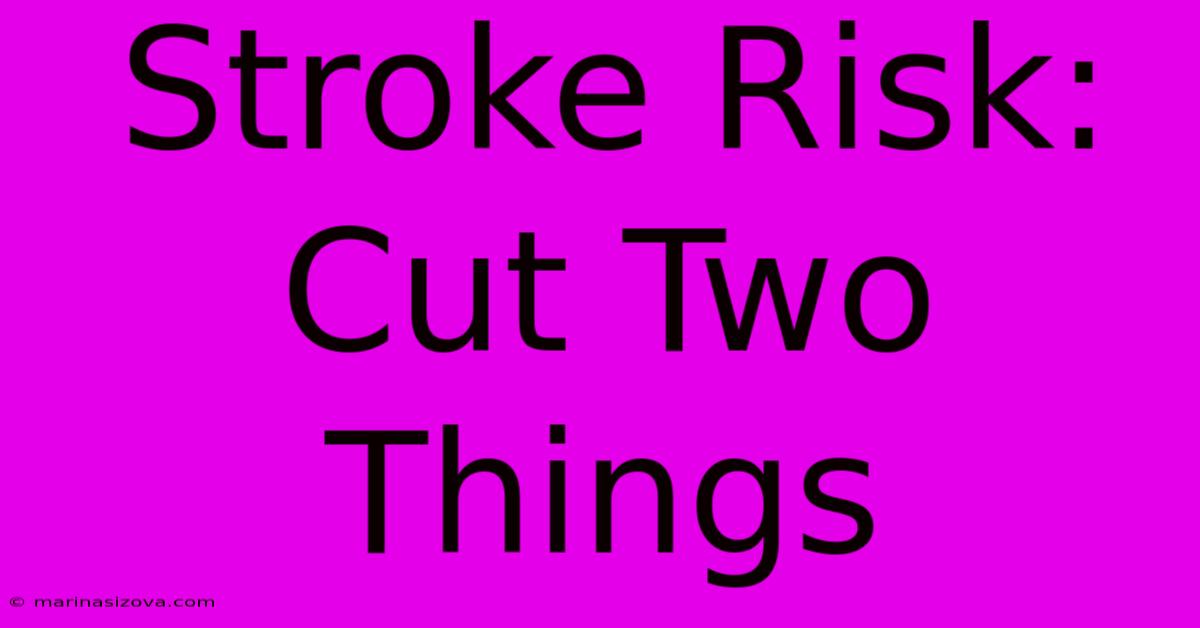Stroke Risk: Cut Two Things

Discover more detailed and exciting information on our website. Click the link below to start your adventure: Visit Best Website. Don't miss out!
Table of Contents
Stroke Risk: Cut Two Things—Discoveries and Insights for a Healthier Life
Is drastically reducing your stroke risk possible by simply cutting two things from your life? The answer is a resounding yes! This guide reveals how eliminating just two major risk factors can significantly impact your chances of experiencing a stroke.
Editor's Note: This comprehensive guide to reducing stroke risk by cutting two key factors has been published today. Learn how simple lifestyle modifications can have a profound impact on your well-being.
Understanding and mitigating stroke risk is crucial; stroke is a leading cause of disability and death globally. This article provides a thorough analysis of two significant modifiable risk factors, empowering individuals to take proactive steps towards a healthier future.
Analysis: This guide is the result of extensive research, drawing from reputable medical journals, health organizations' guidelines, and leading experts' opinions. The aim is to present a clear and concise understanding of stroke risk reduction strategies, enabling informed decision-making.
| Key Insights for Stroke Prevention | Description |
|---|---|
| Eliminate Unhealthy Fats | Reduce saturated and trans fats in your diet |
| Manage High Blood Pressure | Control hypertension through diet, exercise, and/or medication |
Stroke Risk: Cutting Two Major Risk Factors
Introduction
This section highlights the importance of addressing unhealthy fats and high blood pressure in minimizing stroke risk. These are two of the most significant and modifiable factors contributing to cerebrovascular events.
Key Aspects
- Unhealthy Fats: Saturated and trans fats.
- High Blood Pressure: Hypertension, a silent killer.
Discussion
Unhealthy Fats
Introduction: The link between dietary fat and stroke risk is well-established. Saturated and trans fats, in particular, contribute to atherosclerosis, the buildup of plaque in blood vessels. This process restricts blood flow to the brain, increasing the likelihood of a stroke.
Facets:
- Role: Contribute to plaque formation, narrowing arteries.
- Examples: Processed foods, fried foods, red meat.
- Risks: Increased risk of stroke, heart disease.
- Mitigation: Choose lean meats, consume fruits and vegetables.
- Impacts: Improved cardiovascular health, reduced stroke risk.
Summary: Reducing saturated and trans fat intake directly impacts vascular health, significantly reducing the likelihood of stroke.
High Blood Pressure
Introduction: Hypertension, or high blood pressure, is a major contributor to stroke. The sustained pressure on blood vessel walls damages them, making them prone to rupture or blockage.
Facets:
- Role: Damages blood vessels, increases stroke risk.
- Examples: Headaches, dizziness, shortness of breath (severe cases).
- Risks: Stroke, heart attack, kidney failure.
- Mitigation: Lifestyle changes (diet, exercise), medication.
- Impacts: Reduced stroke risk, improved overall health.
Summary: Managing high blood pressure effectively minimizes the strain on blood vessels, directly reducing stroke risk. The connection between controlling blood pressure and preventing stroke is undeniable and crucial.
FAQ
Introduction
This section addresses common questions regarding stroke risk reduction.
Questions
- Q: Are there other risk factors for stroke besides these two? A: Yes, other factors include diabetes, smoking, age, family history, and atrial fibrillation.
- Q: How can I manage high blood pressure effectively? A: Through lifestyle modifications (diet, exercise) and potentially medication prescribed by a physician.
- Q: What types of fats should I consume instead of saturated and trans fats? A: Unsaturated fats, found in olive oil, avocados, nuts, and seeds.
- Q: How often should I get my blood pressure checked? A: Regularly, as advised by your doctor.
- Q: Is it possible to reverse the effects of atherosclerosis? A: While complete reversal might not always be possible, lifestyle changes can slow or even stop its progression.
- Q: What are the early warning signs of a stroke? A: Sudden numbness or weakness, confusion, vision problems, difficulty speaking, severe headache.
Summary
Addressing these frequently asked questions provides a clearer understanding of stroke prevention and management.
Tips for Stroke Risk Reduction
Introduction
This section provides actionable steps for reducing stroke risk.
Tips
- Adopt a heart-healthy diet: Emphasize fruits, vegetables, whole grains, lean proteins, and healthy fats.
- Engage in regular physical activity: Aim for at least 150 minutes of moderate-intensity exercise per week.
- Maintain a healthy weight: Obesity increases stroke risk.
- Limit alcohol consumption: Excessive alcohol intake can raise blood pressure.
- Quit smoking: Smoking significantly increases stroke risk.
- Manage stress effectively: Chronic stress can negatively impact cardiovascular health.
- Monitor your blood pressure regularly: Early detection allows for timely intervention.
- Consult your physician: Develop a personalized plan to address your specific risk factors.
Summary
These tips provide a practical roadmap to significantly lower stroke risk.
Conclusion: A Healthier Future Through Prevention
This exploration of stroke risk reduction underscores the crucial role of eliminating unhealthy fats and managing high blood pressure. By making conscious lifestyle choices, individuals can proactively safeguard their cardiovascular health and dramatically reduce their chances of experiencing a stroke. Early detection and timely intervention are paramount, so regular checkups with a healthcare professional are strongly recommended. Remember, a commitment to healthy living is an investment in a longer, healthier future.

Thank you for visiting our website wich cover about Stroke Risk: Cut Two Things. We hope the information provided has been useful to you. Feel free to contact us if you have any questions or need further assistance. See you next time and dont miss to bookmark.
Featured Posts
-
Reduce Stroke Risk Factor Control
Nov 24, 2024
-
Rangers Dundee United Share Spoils
Nov 24, 2024
-
Making Back To The Future A Musical
Nov 24, 2024
-
Erik Brannstrom Exceeds Expectations In Vancouver
Nov 24, 2024
-
Ruben Amorim Misi Besar Di Manchester United
Nov 24, 2024
